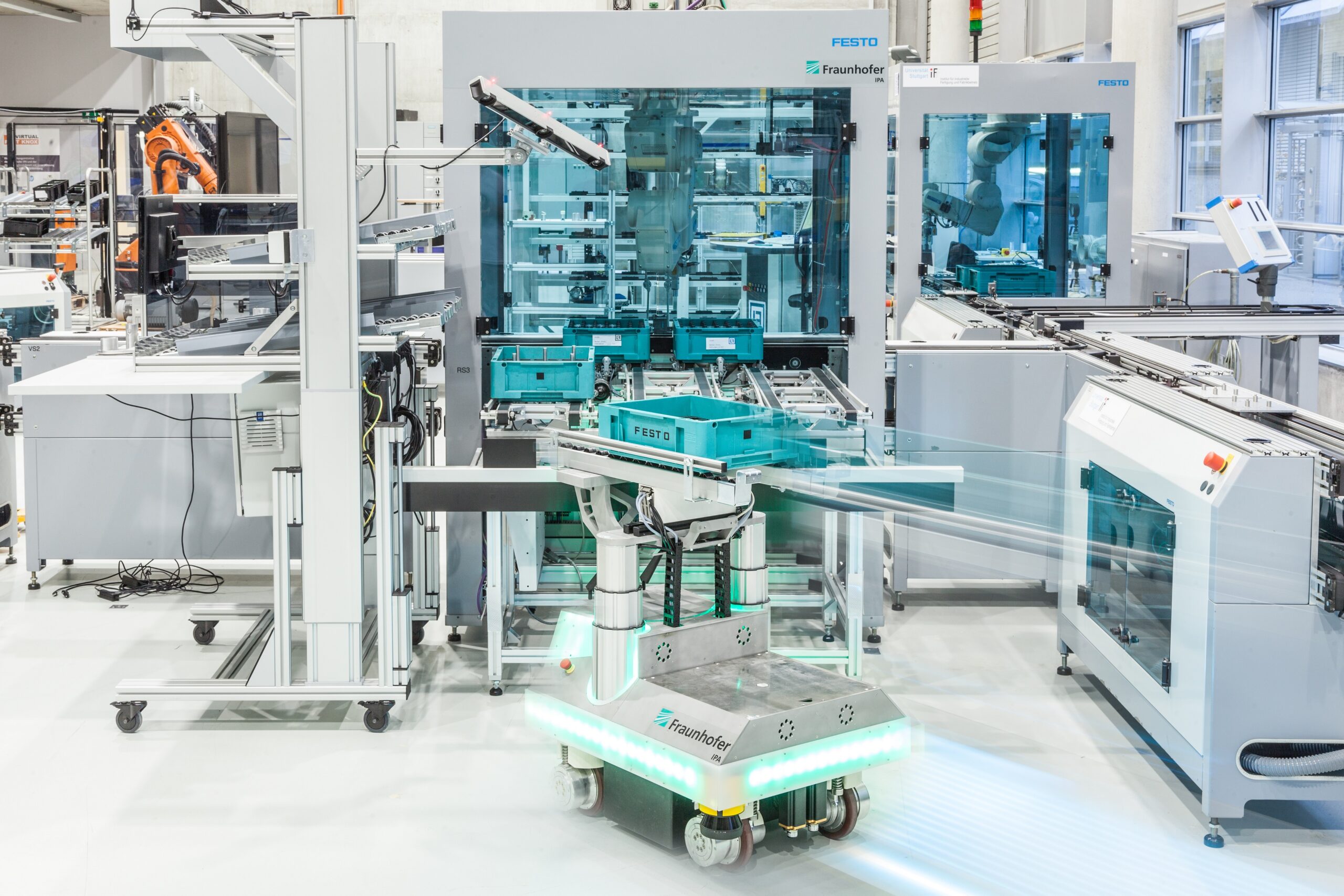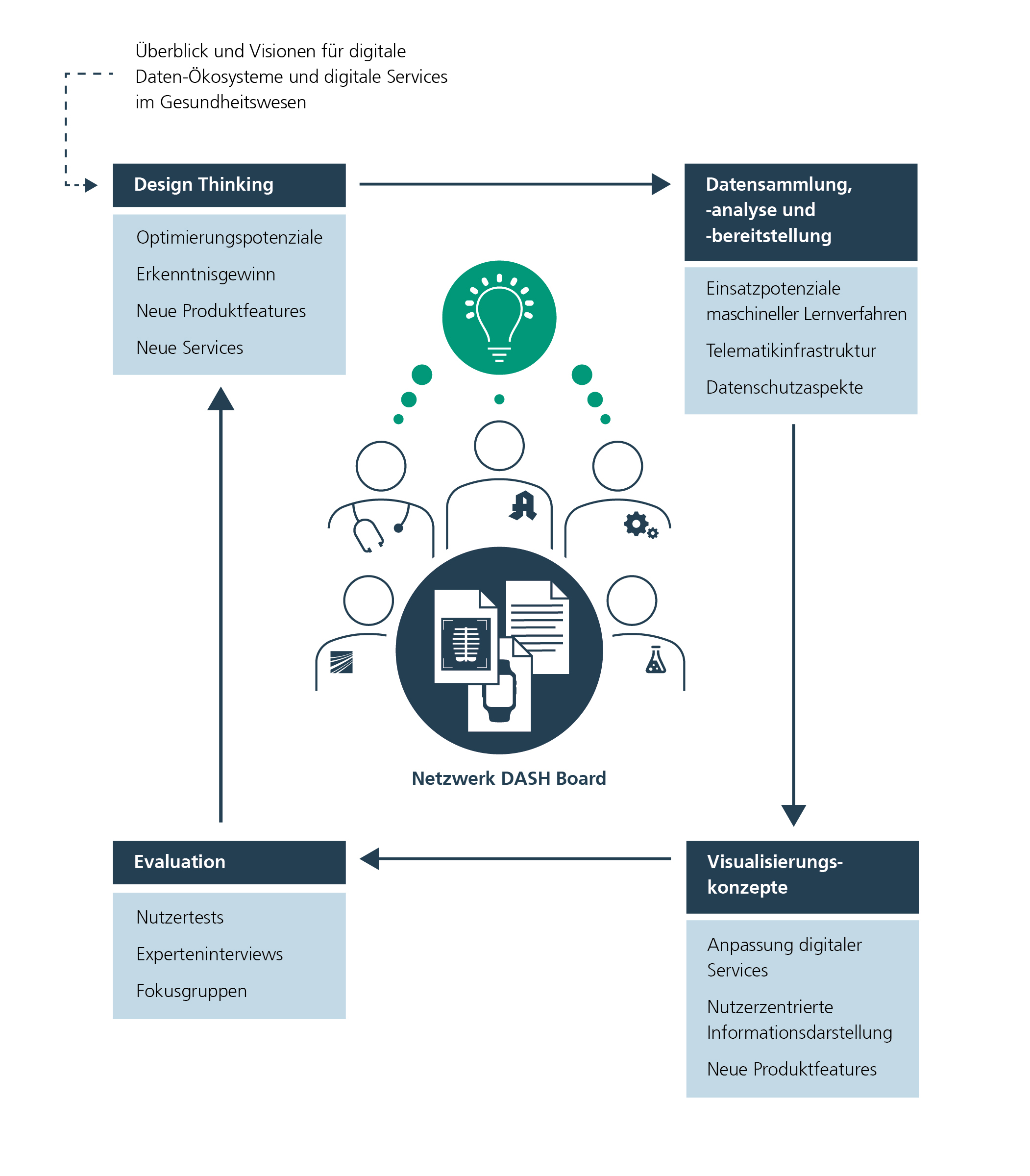DASH Board: Data Analytics for Sustainable Healthcare
Digitalization and personal health data as potential for healthcare
Digitization projects in the healthcare sector are gaining momentum. Doctors are offering advice and assistance online, pharmacies are setting up online stores and clinics are relying on digital information systems. As a result, patients are also increasingly coming into contact with digital services and claiming these new services for themselves. They book their appointments online, obtain information online and use wearables and apps to record and evaluate their health data. Last but not least, the introduction of the electronic patient file (ePA) at the beginning of this year, which will be fully available to patients after a test phase, should be mentioned here.
What specific value do these developments have for service providers and patients? Does ePA really already have the potential to provide full benefits for all users?
Digital healthcare services and their challenges
Especially for the Pharmaceutical industry access to patient-generated health data (PGHD) is becoming increasingly important in order to develop new products and use AI-based tools. This is because it offers immense potential for predicting diseases and determining tailored treatment plans. In the field of pharmacological research, data can be used to derive new drugs and treatment methods. Nevertheless, the incentive to use patient support programs for certain diagnoses or medications has hardly been given so far - neither for patients nor for pharmaceutical companies.
The big Health insurance are already developing their own solutions to enable the exchange and retrieval of health data. The resulting applications enable patients to find out about medication, register vaccinations, document visits to the doctor or receive personal recommendations for check-ups.
(e.g. TK-Safe of the TK). There are also platforms that are intended for nationwide use (e.g. the AOK community's digital health network). However, not all service providers are networked with their customers and patients. In addition, most e-health solutions are still in their infancy and have so far been limited to the major German health insurance funds and their policyholders.
A frequently mentioned added value of digitalization in Hospitals is the avoidance of duplicate examinations if the findings of different service providers or treatment histories of patients can be accessed digitally. The faster overview of anamnesis and treatment data gives practitioners more time for their patients. An electronic medication plan can also help to identify allergies and intolerances at an early stage in order to avoid adverse reactions to medication. These advantages not only promote communication within the hospital, but also the exchange between specialists and GPs, pharmacies and rehabilitation centers. However, the possibilities for consolidating and evaluating information in hospitals remain limited.
the mere digital provision of these has not yet been mentioned.
Optimize the handling of data and information - also for research purposes
Many Patients show great willingness to analyze and optimize their behavior themselves, e.g. via wearables, and also make their data available for larger analysis purposes if they see a benefit in doing so. But what benefits can patients derive from the use of digital services and the availability of their data? What individual incentives can be created for patients?
With the introduction of the electronic patient file (ePA), the potential to merge data in electronic form is now also growing in Germany; a major challenge, however, is the utilization of scanned documents and the pseudonymization of data. For example, a research-compatible ePA is to be made available for university hospitals in order to Research facilities enable access to health data. The potential for the development of medical registers is huge, as they make an important contribution to progress in numerous areas of medicine, such as prevention, therapy optimization and causal research.
With regard to the potential of health data, the following in particular Manufacturer of medical devices standardized data formats and transfer options
a valuable contribution. However, manufacturers are often hardly involved in the approaches to setting up a telematics infrastructure.
taken into account.
In the medical field, there are also Startups difficult: The business of hospitals, pharmaceutical companies and medical device manufacturers is characterized by high investments, long development times and a plethora of legal regulations. However, health-conscious and informed patients often find the developments of the "big players" take too long. They are happy to use new apps and medical gadgets. Artificial intelligence as a new technology is now being taken up by start-ups and implemented in applications with valuable ideas (overview of new start-up applications: https://healthcare-startups.de/). And yet there is a risk of innovations being slowed down because there is not enough data available for the algorithms developed.
Artificial intelligence: opportunities, risks and side effects
The implementation of the electronic patient file (ePA) is already in the starting blocks in Germany. It forms the starting point for a nationwide telematics infrastructure, i.e. a networked, digital ecosystem in which all relevant players in the healthcare system can communicate with each other. We are working hard to implement an appealing user interface, a high level of data security, reliable rights, access and consent management and, last but not least, a seamless, standardized connection to the trust architecture of the telematics infrastructure. It is important to keep an eye on these developments at all times.

The DASH Board network wants to start taking these aspects further today. The implementation of the ePA is seen as a piece of the mosaic that provides a further data source for DASH Board applications. However, as there is already a sufficient amount of health-related data available, the development of Patient-Generated Health Data Services should not be delayed.
How do smart solutions contribute to this process? Artificial intelligence always comes into play when a large amount of data is available in various formats and from different sources. For example, data with these characteristics will initially also be available in the ePA, e.g. image files of X-ray images, doctor's letters in PDF and ICD-10 codes of a diagnosis. AI methods can already help here to read, interpret and annotate the data in order to make it automatically processable with further algorithms. Supported by the expertise of the AI Innovation Center, DASH Board presents and evaluates the AI methods that can be used at this point in the process.
In a next step, AI mechanisms can recognize patterns in the available data, detect anomalies and discover subgroups. In DASH Board, application scenarios are developed that justify the benefits of different analysis approaches. On which devices will the analysis be available to the various stakeholders and in what form will it be made visible? This is what the DASH Board network wants to address in the development of mockups.
The DASH Board network
The DASH Board network ties in with political and social developments as well as the current discourse and addresses the gaps in current data use in order to develop new approaches. The handling of health data, which focuses on the sovereign insured person, guarantees a high level of data protection, conveys trust, but is also compatible with research and of great benefit to service providers, is subject to a range of different expectations and interests. DASH Board therefore invites health insurance companies, pharmaceutical companies, medical device manufacturers, hospitals, healthcare start-ups and research institutions to jointly discuss and prototype solutions for new services, apps and data analysis formats and have them evaluated by patients at an early stage.
The aim of the network is to create the greatest added value for all participants through the shared use of health data. To this end, concrete application scenarios are implemented as prototypes and a high degree of external impact is achieved.
The following questions are answered by the AI Innovation Seed DASH Board:
How do I develop a valuable application scenario for my company/institution in which the use of health data plays a role?
How are the collected application scenarios changing under the influence of big data?
Does my company use or supply data that may also be of interest to other service providers?
What data and formats should be in a data pool that has added value for different service providers?
What motivates our patients to share their health data?
What potential does the different information from patients offer?
It is aimed at companies, institutions and people who have their own interest in using health data, but who are also interested in the concerns of others and recognize the opportunities of shared data use

The vision: promoting sustainability through data donations
Customer management is well known: The more precise the knowledge about the customer, the better they can be offered tailor-made services. The situation is similar when dealing with patients. Individualized service leads to therapy compliance and treatment success. However, every patient program and every therapy generator only works as well as the data basis allows. This requires two key steps: The first step is to collect and understand the information about the patients in order to merge and evaluate the data obtained with as much other patient data as possible in the second step. Only then can we speak of individual performance.
It is clear that effective pseudonymization techniques must ensure that research institutions cannot identify the individuals behind the individual data sets. Legally compliant consent from patients to "data donation", i.e. the transfer of their data to research, is essential. Nevertheless, it is already important to create incentive structures for data donors. It would be conceivable to feed individual results back to the persons concerned - via a trust office - in order to allow users to actively participate in the optimization process. For example, patients who have made their findings available for research over the course of a therapy would learn first-hand what results the radiology department of a university hospital has come to with regard to new treatment methods. Another incentive is a health platform where patients can find out about the latest research on various symptoms and clinical pictures.
Efforts must focus on developing secure and user-friendly systems that can be based on the future telematics infrastructure.
How can I participate in the DASH Board network?
Participation in the funded AI Innovation Seed DASH Board is free of charge for you. Companies with headquarters or at least one branch in Baden-Württemberg that can make a corresponding contribution to the project can apply